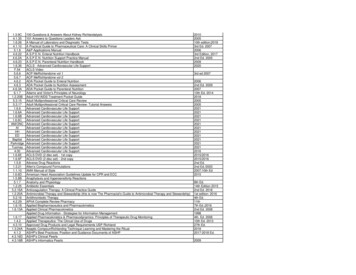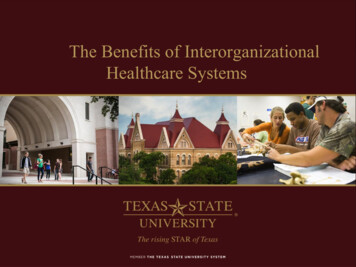
Transcription
Nelissen et al. BMC Pregnancy and Childbirth (2017) 17:301DOI 10.1186/s12884-017-1481-7RESEARCH ARTICLEOpen AccessClinical performance and patient outcomeafter simulation-based training inprevention and management ofpostpartum haemorrhage: an educationalintervention study in a low-resource settingEllen Nelissen1,2* , Hege Ersdal1,3, Estomih Mduma1, Bjørg Evjen-Olsen4,5, Jos Twisk6,7, Jacqueline Broerse8,Jos van Roosmalen8,9 and Jelle Stekelenburg10,11AbstractBackground: Postpartum haemorrhage (PPH) is a major cause of maternal mortality. Prevention and adequatetreatment are therefore important. However, most births in low-resource settings are not attended by skilledproviders, and knowledge and skills of healthcare workers that are available are low. Simulation-based trainingeffectively improves knowledge and simulated skills, but the effectiveness of training on clinical behaviour andpatient outcome is not yet fully understood. The aim of this study was to assess the effect of obstetric simulationbased training on the incidence of PPH and clinical performance of basic delivery skills and management of PPH.Methods: A prospective educational intervention study was performed in a rural referral hospital in Tanzania. Sixteenresearch assistants observed all births with a gestational age of more than 28 weeks from May 2011 to June 2013. InMarch 2012 a half-day obstetric simulation-based training in management of PPH was introduced. Observations beforeand after training were compared. The main outcome measures were incidence of PPH (500–1000 ml and 1000 ml),use and timing of administration of uterotonic drugs, removal of placenta by controlled cord traction, uterine massage,examination of the placenta, management of PPH ( 500 ml), and maternal and neonatal mortality at 24 h.Results: Three thousand six hundred twenty two births before and 5824 births after intervention were included. Theincidence of PPH (500–1000 ml) significantly reduced from 2.1% to 1.3% after training (effect size Cohen’s d 0.07).The proportion of women that received oxytocin (87.8%), removal of placenta by controlled cord traction (96.5%), anduterine massage after birth (93.0%) significantly increased after training (to 91.7%, 98.8%, 99.0% respectively). Theproportion of women who received oxytocin as part of management of PPH increased significantly (before training 43.0%, after training 61.2%). Other skills in management of PPH improved (uterine massage, examination of birth canal,bimanual uterine compression), but these were not statistically significant.Conclusions: The introduction of obstetric simulation-based training was associated with a 38% reduction in incidenceof PPH and improved clinical performance of basic delivery skills and management of PPH.Keywords: Obstetrics, Simulation-based training, Postpartum haemorrhage, Low-resource settings, Education* Correspondence: ellen.nelissen@bristol.ac.uk1Research Department, Haydom Lutheran Hospital, POB 9000, Haydom,Manyara, Tanzania2Department of Obstetrics and Gynaecology, Southmead Hospital,Southmead Road, Bristol BS10 5NB, UKFull list of author information is available at the end of the article The Author(s). 2017 Open Access This article is distributed under the terms of the Creative Commons Attribution 4.0International License (http://creativecommons.org/licenses/by/4.0/), which permits unrestricted use, distribution, andreproduction in any medium, provided you give appropriate credit to the original author(s) and the source, provide a link tothe Creative Commons license, and indicate if changes were made. The Creative Commons Public Domain Dedication o/1.0/) applies to the data made available in this article, unless otherwise stated.
Nelissen et al. BMC Pregnancy and Childbirth (2017) 17:301BackgroundPostpartum haemorrhage is a major cause of maternalmortality. [1] The prevalence of postpartum haemorrhage ranges from 11% to 26% for blood loss more than500 ml, and from 2 to 5% for blood loss more than1000 ml. [2, 3] More than 55% of pregnant women inAfrica suffer from anaemia in pregnancy, [4] and do nothave much reserve when postpartum haemorrhage occurs. Prevention and prompt, adequate treatment ofpostpartum haemorrhage is therefore important. However, many births in sub-Sahara Africa are not attendedby skilled providers. [5] In Tanzania only 51% of allbirths are assisted by a skilled provider. [6] In addition,knowledge and skills of providers are low [5, 7] and inhouse training facilities to keep knowledge and skills ofhealthcare workers up to date hardly exist in lowresource settings. [5, 8] Therefore, Jhpiego (John Hopkins Programme for International Education in Gynaecology and Obstetrics) and Laerdal Global Healthdeveloped Helping Mothers Survive Bleeding After Birth(HMS BAB), a simulation-based training package targetedat healthcare workers in areas with a high burden of maternal morbidity and mortality. [9] The training packagefocuses on basic delivery care, active management of thirdstage of labour, and treatment of postpartum haemorrhage. [10] Simulation-based education, and HMS BAB inspecific, has been shown to effectively increase knowledge,skills, and confidence of healthcare workers [8, 11–13]and is intended to reduce maternal morbidity and mortality caused by postpartum haemorrhage.The four-level Kirkpatrick model is often used to evaluate training programmes (Fig. 1). [14] Most publicationsregarding evaluation of training programmes only addressthe first two levels of this model. [12, 15] Improvement inclinical performance of healthcare workers and patient outcome is the ultimate goal, however most research in thisFig. 1 Kirkpatrick model for evaluating training programmesPage 2 of 9area has been limited to neonatal outcome. [16, 17] Thereis mounting evidence to suggest that training in emergencyobstetric care improves maternal outcome. [18–22]The aim of this study was to assess the effect of obstetric simulation-based training on the incidence ofpostpartum haemorrhage (Kirkpatrick level 4) and clinical performance of basic delivery skills and managementof postpartum haemorrhage (Kirkpatrick level 3) in alow-resource setting.MethodsStudy design and settingWe conducted a prospective educational interventionstudy at Haydom Lutheran Hospital, a rural referral hospital in Northern Tanzania. During the study period, thehospital had 420 beds and provided free reproductivehealth services including comprehensive emergency obstetric care. This incorporated facilities for basic delivery(including the provision of antibiotics, uterotonics, andanticonvulsants), assisted vaginal delivery, removal ofretained products of conception, blood transfusion, andcaesarean section. Extrapolating from the 2002 census,the immediate catchment area of the hospital covered apopulation of approximately 350,000 in 2012, while thegreater reference area covered a population of approximately 2,357,000. [23] The annual number of hospitalbased births at the time of the study was approximately5000.InterventionThe educational intervention took place in March 2012.An overview of research activities is depicted in Fig. 2.Data were prospectively collected from the 25th of May2011 to the 25th of June 2013. A multi-professionalgroup of clinicians, nurse-midwives, medical attendants(nurse aides without formal medical education), and
Nelissen et al. BMC Pregnancy and Childbirth (2017) 17:301Page 3 of 9Fig. 2 Timelineambulance drivers (without formal education) attendeda half-day training course "Helping Mothers SurviveBleeding After Birth”. The training was conducted insmall groups of maximum six participants per facilitator,and consisted of a mix of theory and hands-on practiceusing a low-cost low-tech simulator (MamaNatalie,Laerdal Global Health). The learning goals were to beable to independently manage an uncomplicated delivery, including active management of third stage oflabour by giving 10 IU of oxytocin within one minuteafter birth, and management of postpartum haemorrhage including bimanual uterine compression. Furtherdetails of the intervention and the evaluation of thetraining are described elsewhere. [8]Data measurementSixteen research assistants were trained by the principalinvestigator to structurally observe all births beyond agestational age of 28 weeks in the hospital. To ensureinterrater reliability, the research assistants had a refresher training every three months. Subsequently, theirobservation skills were assessed in simulated scenariosand on labour ward. Any apparent deviations in observations were discussed and corrected immediately. The observations took place in a structured manner using avalidated data collection form with accompanying standard operating procedures. The following background information was recorded for each birth: antenatal careattendance by checking antenatal cards, gestational ageat delivery by measuring fundal symphysis height priorto delivery by the birth attendant (as no 12-week datingscan available), mode of delivery (direct observation),birth weight (direct observation), and training attendance including HMS BAB training (by asking the birthattendant). Furthermore, the primary outcome measurewas recorded: incidence of postpartum haemorrhage.Blood loss was measured as was usual practice in Haydom Lutheran Hospital and comprised visual estimation,measurement using scales, or a mix of both. Themethod of measuring blood loss was also recorded. Postpartum haemorrhage was defined as blood loss of500 ml or more. Severe postpartum haemorrhage wasdefined as blood loss of 1000 ml or more. Secondaryoutcome measures were direct observations and included: use of uterotonic drugs after birth (categorizedas: oxytocin 10 IU, oxytocin 5 IU, none, and other uterotonics such as misoprostol or other dosages of oxytocin),timing of administration of uterotonic drugs, removal ofplacenta by controlled cord traction, uterine massage,and examination of the placenta. In cases complicatedby postpartum haemorrhage, its management was observed: use of uterotonic drugs in addition to those givenroutinely after birth (categorized as: oxytocin 10 IU,ergometrine 0.2 mg, none, and other uterotonics such asmisoprostol or other dosages of oxytocin), uterine massage, examination of perineum, vagina, and/or episiotomy, bimanual uterine compression, hysterectomy, andunits of blood received within 24 h. Lastly, maternal andneonatal outcome at 24 h were recorded. A researchsupervisor reviewed the completed data collection formsregularly. In case of missing information or discrepancies, the data collection form was returned to the
Nelissen et al. BMC Pregnancy and Childbirth (2017) 17:301research assistant to be completed in accordance withthe original hospital notes under supervision of the research supervisor.Sample size considerationIn peer-reviewed articles, incidence rates of postpartumhaemorrhage range between 2 and 26%, depending onthe definition of postpartum haemorrhage and themethod of measuring blood loss. [2, 3, 24, 25] Based onthese data, we hypothesized an incidence of postpartumhaemorrhage (defined as blood loss of 500 ml or more)of 10%. To show a 25% decrease in the incidence ofpostpartum haemorrhage with 80% power and a confidence interval of 95%, a sample of 2010 births before,and the same number of births after intervention wasneeded. If the incidence of postpartum haemorrhagewould lie in the lower range cited in the literature (2%) asample of 11,153 births would be needed before andafter the intervention. If the incidence would be aroundthe upper estimates (26%), the sample size needed wouldbe 656 births before and after intervention.Statistical analysisData were entered twice by two different data clerks andcrosschecked in EpiData (The EpiData Association,Odense, Denmark). We used IBM SPSS Statistics (version 20) for data-analysis (IBM, Armonk, NY, USA). Inorder to assess the effect of the intervention, the studyperiod was divided in two: 25th May 2011 to 6th March2012 (before training) and 13th March 2012 to 25th June2013 (after training). The training course took placefrom the 7th to the 12th of March 2012 and this periodwas excluded from the analysis. Observations before andafter training were compared. Descriptive statistics werecalculated for the background characteristics of womenwho delivered during the study period, the clinical performance of healthcare workers attending births (basicdelivery skills and management of postpartum haemorrhage), and patient outcome. Results are reported innumbers (n) and proportions (%) for categorical variables, and mean and standard deviation (SD) for continuous variables. The chi-square test was used forcomparison of categorical variables. If numbers weresmaller than five, the fisher exact test was used. The independent samples t-test (2-sided) was used to comparecontinuous variables.ResultsThere were 9446 births observed during the studyperiod from May 2011 to June 2013, 3622 births beforeand 5824 births after intervention. Ten clinicians wereworking at the hospital and eight of them attended training (80%). Of the 25 nurse-midwives working in labourward, 15 attended training (60%), and 14 out of 19Page 4 of 9medical attendants attended training (74%). Six out often ambulance drivers were trained (60%). On average54.1% of all births were attended by a HMS BAB trainedhealth care worker. To look at staff turnover, the periodafter training was divided in three-month periods. In thefirst three months after training 31.9% of the births wereattended by a HMS BAB trained health care worker. Inthe second three-month period this proportion was68.8%, then 57.7%, 62.9%, and 48.1% in the consecutivethree-month time periods.Table 1 summarizes the baseline characteristics. Morethan 97% of the women attended antenatal care. Thisremained constant throughout the entire study period.Women giving birth after training had a slightly highermean gestational age (36.4 weeks) compared to womengiving birth before training (36.2 weeks) (p 0.001).Most babies were delivered vaginally (before training82.4%, after training 81.0%). After training more caesarean sections were done (16.1%) compared to beforetraining (13.5%) (p 0.001). Babies born before traininghad a higher mean birth weight (3107 g) compared tobabies born after training (3074 g) (p 0.001).Table 2 shows patient outcome before and after training. Among the births observed (n 9446) there was astatistically significant difference in blood loss betweenbefore (mean 216 ml blood loss, SD 130 ml) and afterintervention (mean 207 ml blood loss, SD 130 ml)(p 0.001). However, Cohen’s effect size value (d 0.07)suggested small practical relevance. After training therewas a significant reduction in the incidence of postpartum haemorrhage (500–1000 ml) from 2.1% to 1.3%(p 0.003). No difference was seen in the group withTable 1 Baseline characteristicsBefore training(n 3622)After training(n 5824)P valueAntenatal care attendance,n (%)3530 (97.5)5684 (97.6)0.46Gestational age, mean(SD), weeksa36.2 (1.1)36.4 (1.3) 0.0012984 (82.4)4717 (81.0)0.07Mode of delivery, n (%)Vaginal deliveryBreech delivery66 (1.8)51 (0.9) 0.001Assisted vaginal delivery26 (0.7)25 (0.4)0.06 0.001Caesarean section488 (13.5)940 (16.1)Missing58 (1.6)91 (1.6)Birth weight, mean(SD), gram3107 (474)3074 (473)0.001Births attended by HMSBAB trained person, n (%)0 (0)3148 (54.1)**aIn most women there was no reliable estimated date of delivery as calculation bylast menstrual period is uncertain and no dating scan facilities are available.Therefore, gestational age was calculated by measuring the fundal symphysisheight prior to delivery**Unable to compute P value as before training no one was trained
Nelissen et al. BMC Pregnancy and Childbirth (2017) 17:301Page 5 of 9Table 2 Incidence of postpartum haemorrhage and patientoutcome before and after interventionTable 3 Basic delivery skillsBefore training,n (%) (n 3622)After training,n (%) (n 5824)P valueBefore training,n (%) (n 3622)After training, n(%) (n 5824)P valueOxytocin, 10 IU3180 (87.8)5338 (91.7) .001 500 ml3529 (97.4)5721 (98.2)0.008Oxytocin, 5 IU69 (1.9)138 (2.4)0.14500–1000 ml77 (2.1)78 (1.3)0.003None108 (3.0)170 (2.9)0.83 1000 ml16 (0.4)25 (0.4)0.93Other247 (6.8)178 (3.1) .001Uterotonic drugsBlood lossMethod of estimating blood lossMissingVisual3236 (89.3)5286 (90.8)0.02Measured165 (4.6)122 (2.1) .001Both221 (6.1)416 (7.1)0.05Maternal outcome after 24 hAdmitted to MW,discharged 24 h1274 (35.2)1594 (27.4) .001Admitted to MW,discharged 24 h2331 (64.4)4201 (72.1) .001Admitted to ICU 24 h16 (0.4)27 (0.5)0.88Death 24 h1 (0.03)2 (0.03)0.86Uterotonic drugsadministered withinone minute after birthMissingRemoval of placenta bycontrolled cord tractionMissingUterine massageMissingExamination of placentaMissing18 (0.5)0 (0)1465 (40.4)2578 (44.3)139 (3.8)176 (3.0)3494 (96.5)5757 (98.8)2 (0.1)0 (0)3367 (93.0)5767 (99.0)4 (0.1)0 (0)1338 (36.9)2157 (37.0)4 (0.1)0 (0)0.001 .001 .0010.96Perinatal outcome after 24 hNormal3423 (94.5)5494 (94.3) .001Any kind of difficulties11 (0.3)58 (1.0) .001Died after birth29 (0.8)50 (0.9)0.84Stillbirth (fresh)58 (1.6)68 (1.2)0.07Stillbirth (macerated)43 (1.2)72 (1.2)0.84Missing58 (1.6)82 (1.4)MW Maternity Ward, ICU Intensive Care Unitblood loss more than 1000 ml (before training 0.4%,after training 0.4%). In most cases blood loss was estimated visually (before training 89.3%, after training90.8%). The number of maternal deaths within 24 h afterbirth did not change after training (n 1 before trainingversus n 2 after training). None of the maternal deathswere attributed to postpartum haemorrhage. Neonatalmortality did not change after training.Table 3 shows the clinical performance of basic deliveryskills before and after training. The proportion of womenreceiving 10 IU of oxytocin after training (91.7%) was significantly higher compared to before training (87.8%).There was no difference in the proportion of women thatdid not receive uterotonic drugs after delivery (beforetraining 3.0%, after training 2.9%). After training, a significantly greater proportion of women received uterotonicdrugs within one minute after birth (before training40.4%, after training 44.3%). Removal of placenta by controlled cord traction and subsequent uterine massage weremore frequently performed after training (98.8% and99.0% respectively) compared to before training (96.5%and 93.0% respectively). There was no difference in theproportion of women that had their placenta examinedfor completeness after delivery (before training 36.9%,after training 37.0%).Table 4 shows management of postpartum haemorrhage before and after training. In the entire studyperiod, 196 women (2.1%) experienced postpartumhaemorrhage of 500 ml blood loss or more. The proportion of women with postpartum haemorrhage receiving10 IU of oxytocin as part of management of postpartumhaemorrhage significantly increased from 43.0% beforetraining to 61.2% after training. The proportion ofwomen with postpartum haemorrhage that did not receive any uterotonic drugs increased from 1.1% beforetraining to 3.9% after training, but this was not statistically significant. After training, more women receiveduterine massage (before 80.6%, after 90.3%), examinationof perineum, vagina, and/or episiotomy (before 51.6%,after 64.1%), and bimanual uterine compression (beforetraining 11.8%, after training 19.4%) as part of the management of postpartum haemorrhage. However, thesechanges were not statistically significant. The proportionof women having a hysterectomy after postpartumhaemorrhage remained constant at around 3%. Thenumber of blood units given within 24 h to women experiencing postpartum haemorrhage increased slightlyfrom an average of 0.4 units before training to an average of 0.7 units after training.DiscussionMain findingsThe incidence of postpartum haemorrhage before theintervention was near the lower limits of the range
Nelissen et al. BMC Pregnancy and Childbirth (2017) 17:301Page 6 of 9Table 4 Management of postpartum haemorrhageBefore training,n (%) n 93After training,n (%) n 103P valueOxytocin, 10 IU40 (43.0)63 (61.2)0.04Ergometrine, 0.2 mg12 (12.9)18 (17.5)0.49None1 (1.1)4 (3.9)0.38Other34 (36.6)18 (17.5)0.001Missing6 (6.5)0 (0)75 (80.6)93 (90.3)Uterotonic drugsUterine massageMissingExamination of perineum,vagina, episiotomyMissingBimanual uterinecompressionMissing6 (6.5)2 (1.9)48 (51.6)66 (64.1)6 (6.5)2 (1.9)11 (11.8)20 (19.4)7 (7.5)0 (0)Hysterectomy3 (3.2)3 (2.9)Missing7 (7.5)0 (0)56 (60.2)59 (57.3)0.190.160.220.99Units of blood given 24 hNo blood given0.261 unit23 (24.7)28 (27.2)0.95 2 units6 (6.5)15 (14.6)0.10Missing8 (8.6)1 (0.9)between 2% and 26% found in the literature. [2, 3, 24,25] Nevertheless, our study showed a 38% reduction(from 2.1% before to 1.3% after training) in the incidenceof postpartum haemorrhage (500–1000 ml) followingthe introduction of the HMS BAB training programme.However, the effect size was low and therefore of smallclinical significance, mainly because of the already lowincidence before the intervention. The reduction in postpartum haemorrhage was associated with an improvement in clinical performance of basic delivery skills andmanagement of postpartum haemorrhage. The latterwas not statistically significant except for an increase inthe use of oxytocin for treatment of postpartum haemorrhage. These results are highly relevant considering thehigh prevalence of anaemia in pregnancy in this population and the fact that most of these settings do not haveblood banks. [26]Strengths and limitationsThe improvements seen after the introduction of thetraining course may be caused by other changes in thehealthcare system. A parallel study on the effect of simulation training in neonatal resuscitation took placearound the same time as this study. In addition, thelabour ward was expanded during the time of the study.However, we do not think these changes had any influence on the outcomes studied in this project, as it hasnot changed practice regarding the prevention and management of postpartum haemorrhage. No new guidelines, protocols, or obstetric initiatives were introducedin the hospital during the study period. Only one personattended an external emergency obstetric care trainingcourse. In addition, we have evaluated the HMS BABprogramme on all four levels of the Kirkpatrick model.[8, 27] Because there is improvement across most levelsof the Kirkpatrick model, we consider it very likely thatthe reduction in incidence of postpartum haemorrhageand improvement in clinical performance was due to thetraining course.It was not feasible to power our study to investigatethe effect of training on maternal mortality. Based on across-sectional study that took place in HaydomLutheran Hospital from 2009 to 2011, [26] we would expect approximately 16 maternal deaths and maternalnear misses related to postpartum haemorrhage (prevalence 0.64%) per year. A sample of approximately 70,000births would be needed to show a reduction of 25% inpostpartum haemorrhage related maternal mortality andsevere maternal morbidity.Gestational age was estimated by measuring the fundalsymphysis height. This is most likely not very accurate asthe mean birth weight in this cohort was around 3100 gand the mean gestational age was 36 weeks. However, thismethod is common practice in most low-resource settings[28] and was used consistently throughout the studyperiod. Therefore, both periods before and after intervention have the same measurement flaw. We have acceptedthis because of unreliable date of last menstrual periodand lack of dating scan possibilities.Lastly, the presence of research assistants may have influenced the performance of the healthcare workers beingobserved (Hawthorne effect). We expect this effect to beminimal as the research assistants had been present inlabour ward for more than two years, collecting data byobserving births for other studies, and were consideredpart of the team working in labour ward. [29–31]InterpretationThe overall incidence of postpartum haemorrhage wasalmost 8% lower than expected. Sheldon et al. describe asimilar finding in the WHO Multicountry Survey onMaternal and Newborn Health. [32] The measured incidence is most likely to be an underestimation of the actual incidence because in the majority of women bloodloss was estimated visually. It is known that subjectivemeasurement of blood loss leads to lower estimates ofthe incidence of postpartum haemorrhage. [3, 33] Furthermore, in our cohort the proportion of women withpostpartum haemorrhage receiving bimanual uterine
Nelissen et al. BMC Pregnancy and Childbirth (2017) 17:301compression and hysterectomy was relatively high, indicating severe bleeding. To objectively measure bloodloss, we explored the use of point-of-care Hb measurements before and after birth and the use of blood collection bags. However, this did not fit our research budgetand the idea met resistance from nurse midwives whoalready experienced a high workload. The likely underestimation of blood loss influences the study power. Inthe group of women with more than 500 ml blood lossafter birth, an improvement in management of postpartum haemorrhage was observed. However, because ofthe lower than expected incidence of postpartum haemorrhage, our sample size was too small to show a statistically significant difference. It is important to emphasizethe need for objective blood loss measurement in futureresearch in low-resource settings. It will not only improve the reliability of the outcomes, but may also improve quality of care in general by better detection ofmajor haemorrhage and subsequent management.A significant increase in caesarean sections was observed after training. Performing caesarean sections wasnot addressed during training. We do not know the reason for this increase, other than a reflection of the globalincrease in caesarean sections, but we know caesareansections are associated with an increased amount ofblood loss after birth compared to vaginal births. [34]This increase in blood loss associated with caesareansections was not seen after training. Instead a reductionof blood loss was seen. The reduction in postpartumhaemorrhage may have been more pronounced if thecaesarean section rate would have remained stable.The results of this study are very relevant for a population in which 76% of women suffer from anaemia inpregnancy. [26] In addition, in many low-resource settings such as Haydom Lutheran Hospital, there is noblood bank and women depend on their relatives forblood for transfusion. A reduction of haemorrhage inthe group with 500–1000 ml blood loss, was assumed tobe possible due to improvement in the basic steps ofmanagement of postpartum haemorrhage such as givingoxytocin, removing the placenta by controlled cord traction, and performing uterine massage. The mannequinthat was used in the HMS BAB training programme hasfeatures that very realistically simulate these basic steps:a placenta that can be removed by controlled cord traction, a uterus that can contract and relax, and the abilityof the mannequin to bleed up to 1500 ml. These featuresmay have helped the learning of these skills. However, inwomen with severe blood loss after birth ( 1000 ml)the basic steps may not have been sufficient enough tocontrol bleeding caused by uterine atony, and certainlynot for other causes of postpartum haemorrhage. Therefore, we were not able to observe a reduction in severepostpartum haemorrhage.Page 7 of 9HMS BAB was also introduced and evaluated in India,Malawi, and Zanzibar in 2012. [13] This study reportedon good acceptability and increase in knowledge andskills after introduction of the training programme, however, it did not report on effect on clinical performanceand patient outcome. Currently, the HMS BABprogramme is being evaluated in Uganda.Other studies investigating the impact of obstetric emergency training report mostly on neonatal outcome, andonly few studies report on maternal outcome. [16, 17] TheQUARITE study showed a reduction in maternal mortality after a multifaceted intervention to promote maternitydeath reviews and onsite training in emergency obstetriccare. [20] Two further studies show a decrease in postpartum haemorrhage after introduction of an obstetric training programme. [18, 21] Sorensen et al. studied theimpact of the Advanced Life Support in Obstetrics(ALSO) course in Tanzania and found no difference in themanagement of prolonged labour and neonatal care. [35]There was, however, a significant improvement in activemanagement of third stage of labour and management ofpostpartum haemorrhage after training. [18] The abovestudies reinforce the results of our study that simulationbased training can be used to improve clinical performance and patient outcome.ConclusionsA half-day obstetric simulation-based training HMS BABwas associated with a reduction in the incidence of postpartum haemorrhage (500–1000 ml). Clinical performance of basic delivery skills and treatment of postpartumhaemorrhage with oxytocin increased significantly aftertraining. Other skills in management of postpartum haemorrhage (uterine massage, examination of birth canal, andbimanual uterine compression) improved after training,but this was not statistically significant. The study powerhas suffered from the much lower than anticipated incidence of postpartum haemorrhage. Future researchshould focus on objective measurement of blood loss andconsider using a randomised study design.AbbreviationsHMS BAB: Helping Mothers Survive Bleeding After Birth; n: number;PPH: Postpartum Haemorrhage; SD: Standard DeviationAcknowledgementsThe authors wish to thank the management, research assistants, and staff ofHaydom Lutheran Hospital.FundingThis study was funded by the Laerdal Foundation for Acute Med
Blood loss was measured as was usual practice in Hay-dom Lutheran Hospital and comprised visual estimation, measurement using scales, or a mix of both. The method of measuring blood loss was also recorded. Post-partum haemorrhage was defined as blood loss of 500 ml or more. Severe postpartum haemorrhage was defined as blood loss of 1000 ml or more.











